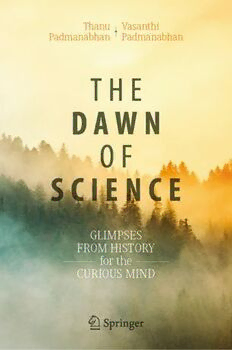
The Dawn of Science: Glimpses from History for the Curious Mind PDF
Preview The Dawn of Science: Glimpses from History for the Curious Mind
TThhaannuu VVaassaanntthii Paaddmmaannaabbhhaann PPaaddmmaannaabbhhaann GLIMPSES FROM HISTORY for the CURIOUS MIND The Dawn of Science Thanu Padmanabhan Vasanthi Padmanabhan (cid:129) The Dawn of Science Glimpses from History for the Curious Mind 123 Thanu Padmanabhan VasanthiPadmanabhan PuneUniversity Campus PuneUniversity Campus IUCAA IUCAA Pune,Maharashtra, India Pune,Maharashtra, India ISBN978-3-030-17508-5 ISBN978-3-030-17509-2 (eBook) https://doi.org/10.1007/978-3-030-17509-2 ©SpringerNatureSwitzerlandAG2019 Thisworkissubjecttocopyright.AllrightsarereservedbythePublisher,whetherthewholeorpart of the material is concerned, specifically the rights of translation, reprinting, reuse of illustrations, recitation, broadcasting, reproduction on microfilms or in any other physical way, and transmission orinformationstorageandretrieval,electronicadaptation,computersoftware,orbysimilarordissimilar methodologynowknownorhereafterdeveloped. The use of general descriptive names, registered names, trademarks, service marks, etc. in this publicationdoesnotimply,evenintheabsenceofaspecificstatement,thatsuchnamesareexemptfrom therelevantprotectivelawsandregulationsandthereforefreeforgeneraluse. The publisher, the authors and the editors are safe to assume that the advice and information in this book are believed to be true and accurate at the date of publication. Neither the publisher nor the authors or the editors give a warranty, expressed or implied, with respect to the material contained hereinorforanyerrorsoromissionsthatmayhavebeenmade.Thepublisherremainsneutralwithregard tojurisdictionalclaimsinpublishedmapsandinstitutionalaffiliations. ThisSpringerimprintispublishedbytheregisteredcompanySpringerNatureSwitzerlandAG Theregisteredcompanyaddressis:Gewerbestrasse11,6330Cham,Switzerland Preface The development of scientific ideas is probably one of the highest intellectual achievementsofHomosapiens.Thisarosefromtheefforts—and,aswewillsee throughout in this book, sacrifices — of a number of dedicated souls. Many of thesecouldprobablyhavequitesuccessfullypursuedtotallydifferentvocationsin life!Buttheyinvolvedthemselveswithsciencebecausetheywere,byandlarge, drivenbycuriosityandwerefascinatedbytheintricaciesofNature.Thisledthem todevote—quiteoften—theirentirelifetimestounravellingthemysteriesofthe worldaroundthem. Thepurposeofthisbookistosharetheexcitementtheauthorsfeelaboutthe historicaldevelopmentofscientificideaswiththelike-minded,curious,educated lay-public.Needlesstosay,thisisnotamonographonthehistoryofsciencewritten byacoupleofhistoriansofscienceforfellowhistoriansofscience.Forone,such volumes—whilenodoubt,excellentinerudition—canbesomewhatsoporificin style;ourintentionisthatyoushouldactuallyenjoyreadingthisbook! Todothisinamodularandentertainingfashion,wehavejustpicked24topics coveringdifferentmilestonesinsciencefromantiquitytillaboutthe17thcentury. WehavestoppedwithNewton’scontributiontophysicsandLavoisier’stochemistry, whichwethinkcouldbethoughtofastheendofaperiodthatwewouldcallthe dawnofscience.Thisendpoint,aswellasthechoiceofthe24milestones,does of course reflect our personal preferences. But we are quite sure that at least 20 outofthese24topicswouldfeatureinanysensiblelistingoftheearlymilestones inthehistoryofscience.Allthesechapters(exceptpossiblyoneortwo)willbe accessibletoanyonewithanexposuretoscienceatthehigh-schoollevel. Therearesomeuniquefeatureswhichwewouldliketoalertyouto,andwhich shouldhelpyoutoenjoyitmore: • To begin with, the book is completely modular and you can dip into any of the chapters independently of the others; so you can read the chapters in any orderthatappealstoyou.Thedevelopmentofideasispresented,byandlarge, v vi Preface chronologically and you might appreciate some chapters more if you read themalongwithcloselyrelated,adjacent,chapters—butthisisbynomeans mandatory.Themodularity,whichmakeseachchapterreasonablyself-contained, also implies that the book should be viewed more like a collection of essays onaconnectingtheme,ratherthanasaconventionalbookmadeupofseveral chapters. • Second,youcanalsoenjoythematerialpresentedinthe“boxes”,mostofthe time,withoutactuallyreadingthroughthemaintextinthechapter.Thisisdone, onceagain,inthespiritofmodularity,andiftheboxesinaparticularchapter attract your attention, then you may like to read it in full! The same goes for the figures and figure captions. We have tried to make history come alive by providingafairnumberoffigures—typicallyhalfadozenperchapter—with reasonablyself-containedfigurecaptions.Youmaywanttoglancethroughthem togetaninitialflavourofwhatthechaptercontains.Thefigurecaptionsinclude acertainamountofunavoidabletextoverlapwiththemainbodyofthechapter, butthisshouldbeconsideredafeatureratherthanabug! • Third,allthechapterscontainaspecialdiagramentitled“When”(andsomeof thechaptersalsocontainadiagramentitled“Where”).Thisdiagramsummarizes theeventsinthehistoricalperioddescribedinthatparticularchapter.Totheleft ofthetimeline,youcanseethekeyeventsinscience,whiletotherightofthe timelinewehavegiventhekeyeventsinworldhistory(andIndianhistory,as youwouldnaturallyexpectfromtwoIndianauthors!).Thiswillallowyouto appreciatethewayscienceinterfacedwithsocialstructuresandpoliticalevents asitdeveloped. • Fourth,wehaveinterpretedthedevelopmentofscientificideasinareasonably broad context. For example, we have included chapters on the exploration of thehighseas,thestoryofthecalendarsystem,andthedevelopmentofprinting inthiscollectionofmilestones.Westronglybelievethattheydeserveaplace herebecauseofthesymbioticrelationshiptheyhadwiththe—morenarrowly defined—aspectsofscientificdevelopment.Suchaholisticapproachtowards thehistoryofscience,wefeel,isnotonlyjustified,butessential. • We started by saying that this book is intended for the lay-public and not for historiansofscience.Butifyoudowanttoknowmoreabouteachofthetopics covered here, we have provided ample references to the literature (with brief annotations)attheendofeachchapter.Manyoftheseworksarequiteeruditeand Preface vii scholarlyandwillcertainlyprovideyouwithmaterialtowhetyourappetite.But ifyouarehappywithourstory-telling,youcanignorethereferences!Wehave donetheresearchforyouand,inparticular,wheneversomeoftheincidences quotedinthetextarecontroversial,wehavetakencaretoalertyoutothis. Thedevelopmentofsciencecannotbeviewedinisolation,awayfromthesocial and political context in which it is taking place. You will find that we have not shiedawayfromcommentingontheinfluenceofsocial,economic,andreligious developmentsonscience.Unfortunately,theseinfluenceshavebeenrathernegative in many crucial phases, but becoming aware of this fact is an important part of one’seducation.Inasimilarspirit,wehavetriedtoportrayscientistsasnormal humanbeingswithnormalhumanweaknessesandemotions(inspiteofbeingthe intellectualgiantstheywere). We have also tried to correct, whenever possible, the view that history is a frozentopic.Thisisnottrueaboutanybranchofhistoryandcertainlynotinthe caseofthehistoryofscience.Afewofthehistoricalfactsdescribedhere—suchas thedevelopmentofcalculusinsouthIndia,centuriesbeforeNewtonandLeibnitz —havecometolightonlywithinthelastfewdecadesandhencearenotaswidely knownastheydeservetobe.Tothatextent,thehistoryofscienceisverymuch aliveandevolvinginitself. Manypeoplehavecontributedatdifferentstagestothemakingofthisbook. Severalofthechaptersoverlapintheirintellectualcontentwithaseriesofarticles oneofus(TP)wroteforthejournalResonancein2010–2012,eventhoughthey haveallundergoneasignificantamountofrewritingandexpansion.Wethankthe IndianAcademyofSciencesforgrantingpermissiontoSpringerforthereuseof thematerialinthesearticles. Manyofourcolleagueswentthroughearlierdraftsofthisbookandprovided comments. We thank Jasjeet Bagla, Yashoda Chandorkar, V. Chelladurai, S.M. Chitre,SunuEngineer,HarvinderJassal,KinjalkLochan,SunitaNair,J.V.Narlikar, HamsaPadmanabhan,KrishnamohanParattu,K.Srinivasan,andTejinderSingh fortheirhelp. Most of the figures have been reproduced from the public domain and we thank those who made them available in this manner for the wider use of the community.Inaddition,somefiguresinChaps.4,5,6,and24werereproduced withexplicitpermissionfrom:WellcomeLibrary,London(Fig.4.4),Collection ofMichiganMedicine,UniversityofMichiganGiftofPfizer(Figs.5.1,5.2,and 5.3),WolfgangVolk,Berlin(Fig.6.1right)andtheSpecialcollections&Archives ResearchCenter,OregonStateUniversityLibraries(Fig.24.4),andwearegrateful viii Preface tothemforgrantingusthispermission.(Youwillfindthecreditlinesforallthe figures,includingthosetakenfromthepublicdomain,attheendofeachchapter.) We also thank Manjiri Mahabal for the help she provided in her spare time as regardstheorganizationoffiguresandfigurecredits. Finally,itisapleasuretothankAngelaLaheeofSpringerforalltheassistance shehasprovidedinthisproject.Sheencouragedustobringoutthisbookandwas extremely helpful and supportive at every stage of its preparation. It has been a distinctpleasuretointeractwithherasafriendandworkwithherasarepresentative ofSpringer. Pune,India ThanuPadmanabhan January2019 VasanthiPadmanabhan Contents 1 IntheBeginning... ........................................... 1 2 TheAthenianContribution .................................... 11 3 FromtheIshangoBonetoEuclid ............................... 21 4 Archimedes—theGiantAmongtheAncients.................... 31 5 TheHealingArtandItsScience ................................ 43 6 TheLegacyfromtheArabWorld............................... 53 7 TheIndo-ArabicNumerals .................................... 69 8 ThePrintingofaPage......................................... 79 9 Exploringthe‘SevenSeas’ ..................................... 89 10 TheFirstStepsofModernMedicine ............................ 105 11 MakingtheEarthMove ....................................... 117 12 TheLogarithm—AnUnsungHero............................. 127 13 TheWayoftheWanderers..................................... 137 14 GalileoandtheDynamicalWorld............................... 151 15 AffairsoftheHeart ........................................... 161 ix x Contents 16 TheWeightoftheIntangible ................................... 171 17 GeometrywithoutFigures ..................................... 183 18 Life’sInfiniteVariety:FindingOrderinSpecies ................. 193 19 AMeasureoftheHeavens ..................................... 205 20 CalculusDevelopedinSouthIndia.............................. 213 21 StoryoftheCalendar ......................................... 225 22 AndThenAllWasLight....................................... 239 23 TheThirstforPower .......................................... 255 24 ChemistryComesofAge ...................................... 265 Index ........................................................... 279
